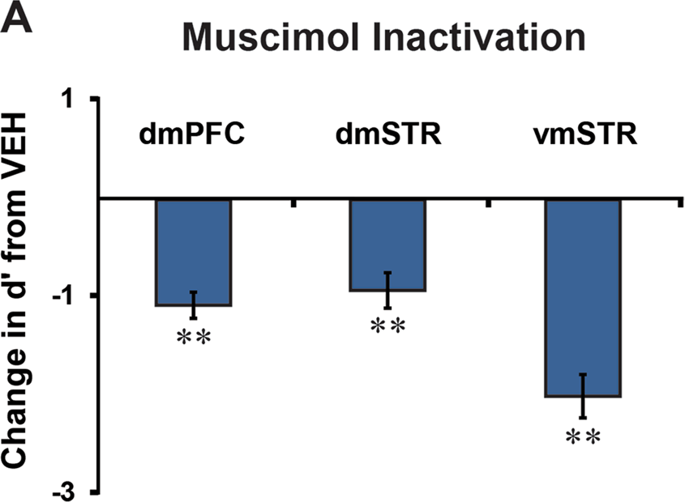当前位置:
X-MOL 学术
›
Neuropsychopharmacology
›
论文详情
Our official English website, www.x-mol.net, welcomes your feedback! (Note: you will need to create a separate account there.)
Receptor and circuit mechanisms underlying differential procognitive actions of psychostimulants.
Neuropsychopharmacology ( IF 7.6 ) Pub Date : 2019-01-11 , DOI: 10.1038/s41386-019-0314-y Robert C Spencer 1 , Craig W Berridge 1
Neuropsychopharmacology ( IF 7.6 ) Pub Date : 2019-01-11 , DOI: 10.1038/s41386-019-0314-y Robert C Spencer 1 , Craig W Berridge 1
Affiliation

|
Psychostimulants, including methylphenidate (MPH), improve cognitive processes dependent on the prefrontal cortex (PFC) and extended frontostriatal circuitry. In both humans and animals, systemic MPH improves certain cognitive processes, such as working memory, in a narrow inverted-U-shaped manner. In contrast, other processes, including attention-related, are improved over a broader/right-shifted dose range. The current studies sought to elucidate the potential circuit and receptor mechanisms underlying the divergent dose-dependent procognitive effects of psychostimulants. We first observed that, as with working memory, although sustained attention testing was highly dependent on multiple frontostriatal regions, only MPH infusion into the dorsomedial PFC improved task performance. Importantly, the dose-response curve for this action was right-shifted relative to working memory, as seen with systemic administration. Additional studies examined the receptor mechanisms within the PFC associated with the procognitive actions of MPH across working memory and sustained attention tasks. We observed that PFC α2 and D1 receptors contributed to the beneficial effects of MPH across both cognitive tasks. However, α1 receptors only contributed to MPH-induced improvement in sustained attention. Moreover, activation of PFC α1 receptors was sufficient to improve sustained attention. This latter action contrasts with the impairing actions of PFC α1 receptors reported previously for working memory. These results provide further evidence for a prominent role of the PFC in the procognitive actions of MPH and demonstrate the divergent dose sensitivity across cognitive processes aligns with the differential involvement of PFC α1 receptors.
中文翻译:

精神兴奋剂差异促认知作用的受体和电路机制。
包括哌醋甲酯 (MPH) 在内的精神兴奋剂可改善依赖于前额叶皮层 (PFC) 和扩展的额纹状体电路的认知过程。在人类和动物中,系统性 MPH 以狭窄的倒 U 形方式改善某些认知过程,例如工作记忆。相比之下,其他过程,包括与注意力相关的过程,在更广泛/右移的剂量范围内得到了改进。目前的研究试图阐明精神兴奋剂不同剂量依赖性促认知作用的潜在回路和受体机制。我们首先观察到,与工作记忆一样,尽管持续注意力测试高度依赖于多个额纹状体区域,但只有 MPH 输注到背内侧 PFC 才能提高任务表现。重要的,该作用的剂量反应曲线相对于工作记忆右移,如全身给药所见。其他研究检查了 PFC 内与 MPH 在工作记忆和持续注意力任务中的促认知作用相关的受体机制。我们观察到 PFC α2 和 D1 受体有助于 MPH 在两项认知任务中的有益作用。然而,α1 受体仅有助于 MPH 诱导的持续注意力改善。此外,PFC α1 受体的激活足以提高持续注意力。后一种作用与先前报道的 PFC α1 受体对工作记忆的损害作用形成对比。
更新日期:2019-01-26
中文翻译:

精神兴奋剂差异促认知作用的受体和电路机制。
包括哌醋甲酯 (MPH) 在内的精神兴奋剂可改善依赖于前额叶皮层 (PFC) 和扩展的额纹状体电路的认知过程。在人类和动物中,系统性 MPH 以狭窄的倒 U 形方式改善某些认知过程,例如工作记忆。相比之下,其他过程,包括与注意力相关的过程,在更广泛/右移的剂量范围内得到了改进。目前的研究试图阐明精神兴奋剂不同剂量依赖性促认知作用的潜在回路和受体机制。我们首先观察到,与工作记忆一样,尽管持续注意力测试高度依赖于多个额纹状体区域,但只有 MPH 输注到背内侧 PFC 才能提高任务表现。重要的,该作用的剂量反应曲线相对于工作记忆右移,如全身给药所见。其他研究检查了 PFC 内与 MPH 在工作记忆和持续注意力任务中的促认知作用相关的受体机制。我们观察到 PFC α2 和 D1 受体有助于 MPH 在两项认知任务中的有益作用。然而,α1 受体仅有助于 MPH 诱导的持续注意力改善。此外,PFC α1 受体的激活足以提高持续注意力。后一种作用与先前报道的 PFC α1 受体对工作记忆的损害作用形成对比。



























 京公网安备 11010802027423号
京公网安备 11010802027423号